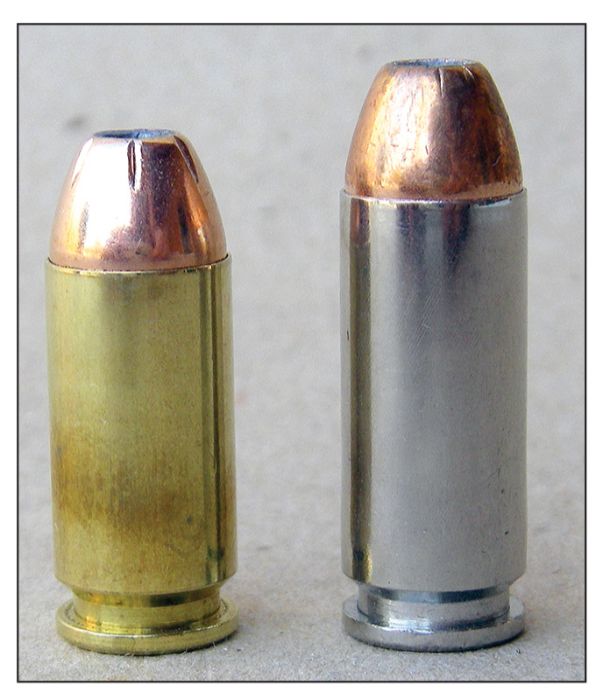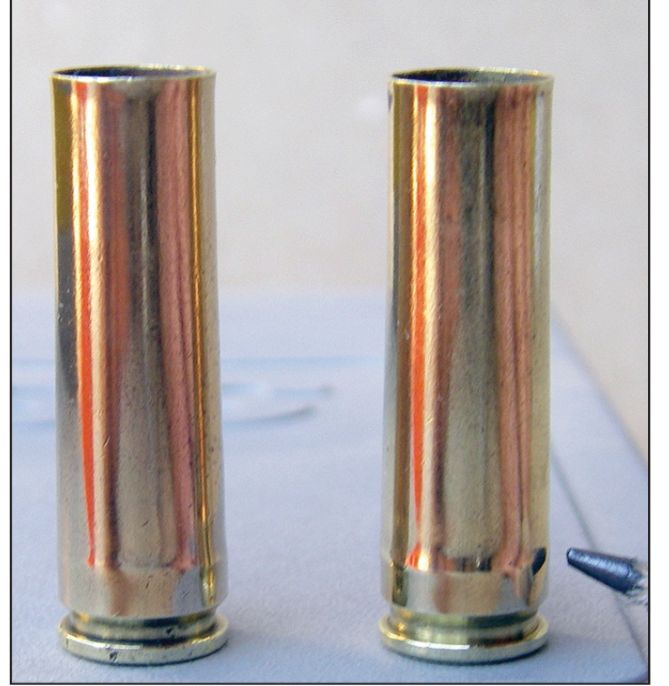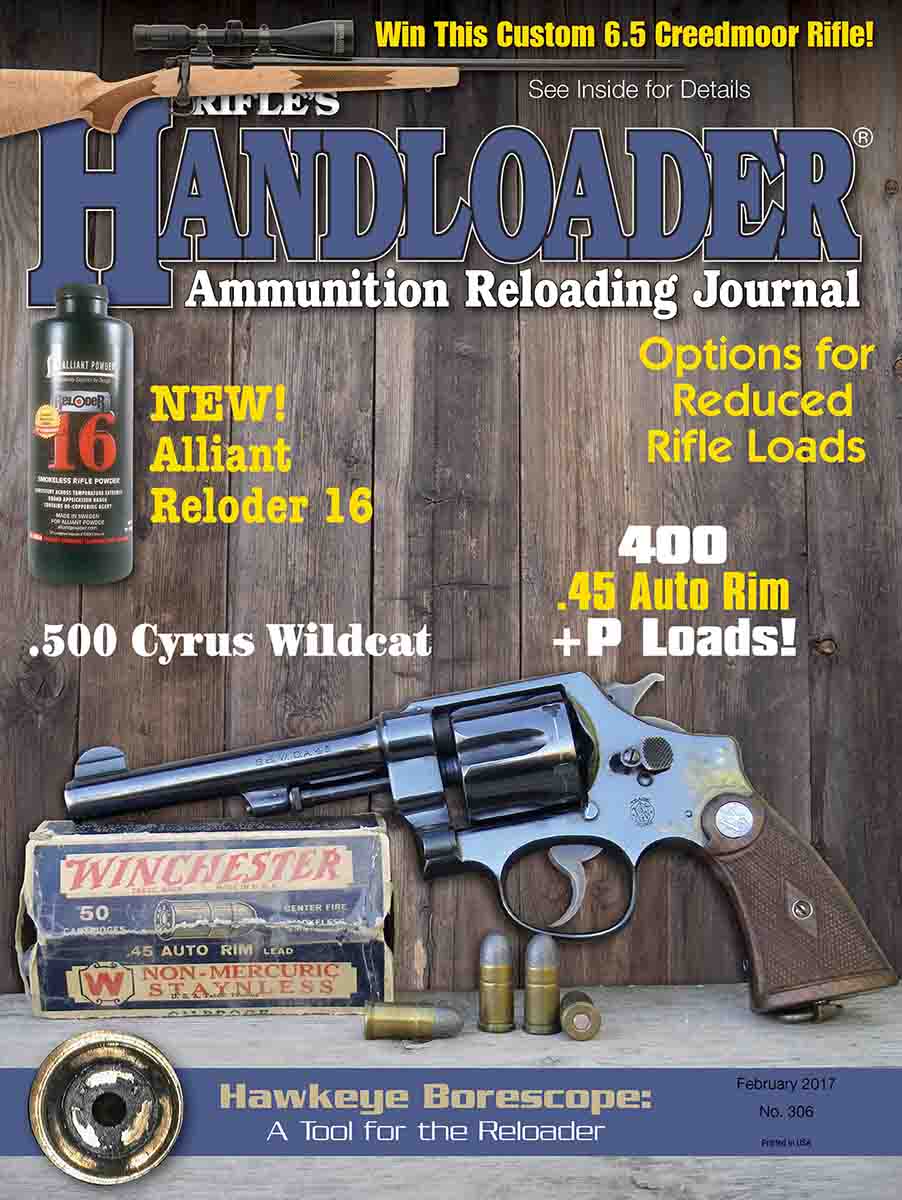Bullets & Brass
.40 S&W and 10mm Auto Interchangeability
column By: Brian Pearce | February, 17
Q: I have been a shooter and reloader going on 30 years. My late brother got me started, and I began my hobby while stationed in Alaska. I have always been a revolver type, and despite my best efforts, I can’t seem to get enthused about all the semiautomatic handguns (with the exception of the 1911-style pistol). I have been subscribing to Handloader as long as I have been reloading.
One of the revolvers I own is a Ruger New Model Blackhawk Buckeye Special .38-40 Winchester with an extra cylinder in 10mm Auto. Although I mostly use the .38-40 cylinder, I began wondering why I couldn’t shoot .40 S&W cartridges in the 10mm cylinder. After all, we shoot .38 Specials in .357 Magnum revolvers, .44 Specials in .44 Magnums, and most recently Starline is offering the .41 Special that can be used in .41 Magnums. In each case the Special brass is slightly shorter than the parent magnum case. The same can be said for the .40 S&W and 10mm. Yet when I wrote Ruger, I was advised not to shoot .40 S&W rounds in the 10mm Auto cylinder. No reasoning was offered, but my guess is liability issues drive the answer.

I have never understood why you can’t do this. Is there some physical, mechanical or cartridge pressure reason why you can’t interchange this semiauto round like you do the more traditional revolver rounds? Any insight that you can offer would be greatly appreciated. – M.W.L., Prescott AZ
A: Traditional revolver cartridges headspace on the rim, which allows the Special (or shorter) cases to headspace correctly and fire in the magnum chambers. On the other hand, most autoloading pistol cartridges headspace on the case mouth, which is the situation with the .40 S&W and 10mm Auto. As a result, if you were to try to fire .40 S&W cartridges in the 10mm cylinder, they will drop into the chamber too far to permit the firing pin to contact the primer to achieve reliable ignition – with the possible exception being if the revolver was pointed straight up.
It should be noted that some shooters fire .40 S&W cartridges in their 10mm Auto pistols, and they usually ignite with some degree of reliability. The difference is that the extractor of most 10mm pistols will hold the .40 S&W cartridge firmly enough against the breech face to allow the firing pin to strike the primer and fire. The extractor also prevents cartridges from entering the chamber too deeply, as described above with revolvers. However, because of improper and uncontrolled headspacing and excessive bullet jump within the chamber, accuracy is extremely poor. For several reasons that I will not take the time to discuss here, I never recommend firing .40 S&W cartridges in any 10mm Auto pistol.
If you really want to fire .40 S&W cartridges in your Ruger New Model Blackhawk .38-40/ 10mm Auto revolver, the correct way to accomplish this is to have a custom gunsmith install a new cylinder so chambered, which if done correctly, may not be as costly as you would expect.
.45 Colt Data

Q: I thoroughly enjoy Handloader magazine, and in spite of being a handloader for more than 40 years, I always learn something new from each of your articles. I especially enjoy your pieces on sixgun cartridges, loads, hunting and long-range shooting with them.
My question is in regard to .45 Colt data. I have been using the 200-grain RNFP for cowboy action shoots but have recently switched to the 250-grain RNFP from Oregon Trail, as I am getting better accuracy. I have had very good results with this bullet, but recently the local dealer has not had them on the shelf. Any suggestions on how to find them would be appreciated. The dealer did have some of the 260-grain TC cast bullets from Rim Rock Bullets, so I purchased 1,000 of them.
After getting home and preparing to load them, I realized this bullet is 10 grains heavier and may not be suitable with the same powder charges I have been using. I am shooting an early third-generation Colt Single Action Army and do not want to push its limits. I have been using IMR’s Hi-Skor 700-X powder but have recently switched to 7.1 grains of Accurate No. 2 powder (based on your suggestion). Can you suggest a powder charge for the 260-grain bullet? Thanks in advance for your help, and keep those articles coming. – T. S., Fairfield ID
A: Thank you for your kind words and for taking the time to read our magazine. The 260-grain Truncated Cone Rim Rock bullet seats out of the case farther than the Oregon Trial 250-grain RNFP, which increases case capacity, and it has a longer overall cartridge length of around 1.630 inches, whereas the 250-grain bullet typically seats at 1.575 inches. The increase in case capacity will reduce pressures and offsets the pressure changes due to the increased bullet weight. In other words, you can use the same 7.1-grain powder charge of Accurate No. 2 powder that you have been using with the250-grain RNFP bullet, and it
will not exceed industry pressure guidelines for the .45 Colt and is suitable in your Colt Single Action Army. Incidentally, Oregon Trail bullets can be ordered factory direct at 1-800-811-0548.
.30 Carbine Range Brass
Q: I have just started handloading for the .30 Carbine, and because of availability issues with brass and bullets, I had to buy oncefired range reclaimed brass with mixed headstamps. About 2 percent of them have been swelled enough that they will not fit in the shellholder. I have not used any of these, just in case they were fired with a too-hot load and have been damaged. Some of the brass that I have been able to size has a bulge at the bottom after sizing. Do you have any suggestions to remove this bulge? – L.N., Nikiski AK

A: The bulge you describe, which I can only assume is on the case body just forward of the solid head, can be difficult to remove. I have been able to eliminate it by using a solid steel sizing die adjusted so that it firmly contacts the shellholder during the sizing process. If carbide dies are preferred, you might try the Lee Precision version, as its carbide ring insert is very close to the die mouth and will usually remove this bulge. Starline is now manufacturing .30 Carbine cases, which are readily available factory direct at 1-800-280-6660.


